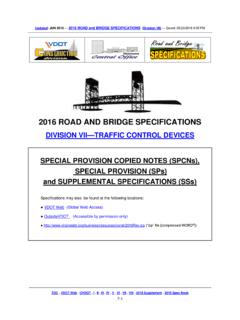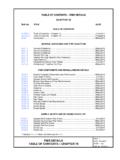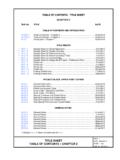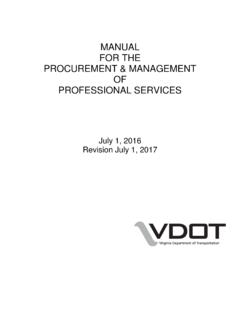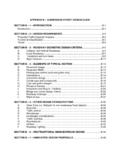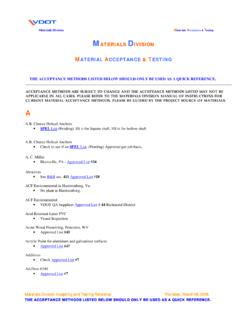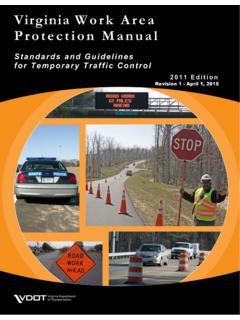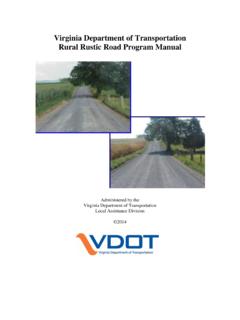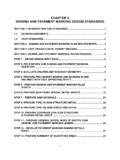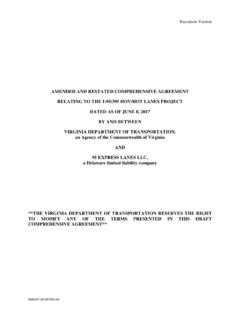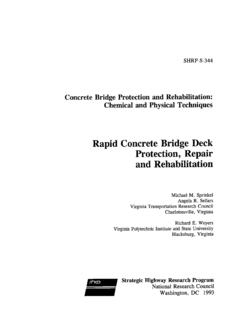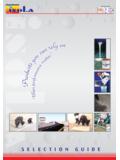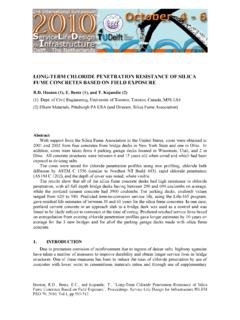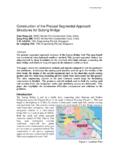Transcription of RECOMMENDATIONS FOR THE CONNECTION BETWEEN …
1 FINAL. CONTRACT REPORT. VTRC 07-CR17. RECOMMENDATIONS . FOR THE CONNECTION . BETWEEN full - depth precast . bridge DECK PANEL SYSTEMS. AND precast I-BEAMS. DON P. SCHOLZ. Graduate Research Engineer JOSEPH A. WALLENFELSZ. Graduate Research Engineer CINTIA LIJERON. Undergraduate Research Assistant CARIN L. ROBERTS-WOLLMANN, , Associate Professor Via Department of Civil and Environmental Engineering Virginia Polytechnic Institute & State University Standard Title Page - Report on Federally Funded Project 1. Report No.: 2. Government Accession No. 3. Recipient's Catalog No. FHWA/VTRC 07-CR17. 4. Title and Subtitle: 5. Report Date: RECOMMENDATIONS for the CONNECTION BETWEEN full - depth precast bridge June 2007.
2 Deck Panel Systems and precast I-Beams 6. Performing Organization Code 7. Author(s): 8. Performing Organization Report No. Don P. Scholz, Joseph A. Wallenfelsz, Cintia Lijeron, and VTRC 07-CR17. Carin L. Roberts-Wollmann 9. Performing Organization and Address: 10. Work Unit No. (TRAIS). Virginia Transportation Research Council 530 Edgemont Road 11. Contract or Grant No.: Charlottesville, VA 22903 79867. 12. Sponsoring Agencies' Name and Address: 13. Type of Report and Period Covered Virginia Department of Transportation Federal Highway Administration Final Contract 1401 E. Broad Street 400 North 8th Street, Room 750 14. Sponsoring Agency Code Richmond, VA 23219 Richmond, VA 23219-4825. 15.
3 Supplementary Notes 16. Abstract precast bridge deck panels can be used in place of a cast-in-place concrete deck to reduce bridge closure times for deck replacements or new bridge construction. The panels are prefabricated at a precasting plant providing optimal casting and curing conditions, which should result in highly durable decks. precast panels can be either full - depth or partial- depth . Partial- depth panels act as a stay-in-place form for a cast-in-place concrete topping. This study investigated only the behavior of full - depth precast panels. The research described in this report had two primary objectives. The first was to develop a performance specification for the grout that fills the haunch BETWEEN the top of the beam and the bottom of the deck panel, as well as the horizontal shear connector pockets and the panel-to-panel joints.
4 Tests were performed using standard or modified ASTM tests to determine basic material properties on eight types of grout. The grouts were also used in tests that approximated the conditions in a deck panel system. Based on these tests, requirements for shrinkage, compressive strength, and flow were established for the grouts. It was more difficult to establish a test method and an acceptable performance level for adhesion, an important property for the strength and durability of the deck panel system. The second objective was to quantify the horizontal shear strength of the CONNECTION BETWEEN the deck panel and the beam prestressed concrete beams. This portion of the research also investigated innovative methods of creating the CONNECTION .
5 Push-off tests were conducted using several types of grout and a variety of connections. These tests were used to develop equations for the horizontal shear strength of the details. Two promising alternate connections, the hidden pocket detail and the shear stud detail, were tested for constructability and strength. The final outcome of this study a set of RECOMMENDATIONS for the design, detailing, and construction of the CONNECTION BETWEEN full - depth precast deck panels and prestressed concrete I-beams. If designed and constructed properly, the deck panel system is an excellent option when rapid bridge deck construction or replacement is required. 17 Key Words 18. Distribution Statement full - depth precast bridge deck panels, grout performance No restrictions.
6 This document is available to the public through specification, deck panel girder CONNECTION , horizontal shear NTIS, Springfield, VA 22161. strength 19. Security Classif. (of this report) 20. Security Classif. (of this page) 21. No. of Pages 22. Price Unclassified Unclassified 78. Form DOT F (8-72) Reproduction of completed page authorized FINAL CONTRACT REPORT. RECOMMENDATIONS FOR THE CONNECTION BETWEEN full - depth . precast bridge DECK PANEL SYSTEMS AND precast I-BEAMS. Don P. Scholz Graduate Research Engineer Joseph A. Wallenfelsz Graduate Research Engineer Cintia Lijeron Undergraduate Research Assistant Carin L. Roberts-Wollmann, , Associate Professor Via Department of Civil and Environmental Engineering Virginia Polytechnic Institute & State University Project Manager Rodney Davis, , , Virginia Transportation Research Council Contract Research Sponsored by the Virginia Transportation Research Council Virginia Transportation Research Council (A partnership of the Virginia Department of Transportation and the University of Virginia since 1948).
7 In Cooperation with the Department of Transportation Federal Highway Administration Charlottesville, Virginia June 2007. VTRC 07-CR17. NOTICE. The project that is the subject of this report was done under contract for the Virginia Department of Transportation, Virginia Transportation Research Council. The contents of this report reflect the views of the authors, who are responsible for the facts and the accuracy of the data presented herein. The contents do not necessarily reflect the official views or policies of the Virginia Department of Transportation, the Commonwealth Transportation Board, or the Federal Highway Administration. This report does not constitute a standard, specification, or regulation.
8 Each contract report is peer reviewed and accepted for publication by Research Council staff with expertise in related technical areas. The contractor performs final editing and proofreading of the report. Copyright 2007 by the Commonwealth of Virginia. All rights reserved. ii ABSTRACT. precast bridge deck panels can be used in place of a cast-in-place concrete deck to reduce bridge closure times for deck replacements or new bridge construction. The panels are prefabricated at a precasting plant providing optimal casting and curing conditions, which should result in highly durable decks. precast panels can be either full - depth or partial- depth . Partial- depth panels act as a stay-in-place form for a cast-in-place concrete topping.
9 This study investigated only the behavior of full - depth precast panels. The research described in this report had two primary objectives. The first was to develop a performance specification for the grout that fills the haunch BETWEEN the top of the beam and the bottom of the deck panel, as well as the horizontal shear connector pockets and the panel-to-panel joints. Tests were performed using standard or modified ASTM tests to determine basic material properties on eight types of grout. The grouts were also used in tests that approximated the conditions in a deck panel system. Based on these tests, requirements for shrinkage, compressive strength, and flow were established for the grouts.
10 It was more difficult to establish a test method and an acceptable performance level for adhesion, an important property for the strength and durability of the deck panel system. The second objective was to quantify the horizontal shear strength of the CONNECTION BETWEEN the deck panel and the beam prestressed concrete beams. This portion of the research also investigated innovative methods of creating the CONNECTION . Push-off tests were conducted using several types of grout and a variety of connections. These tests were used to develop equations for the horizontal shear strength of the details. Two promising alternate connections, the hidden pocket detail and the shear stud detail, were tested for constructability and strength.
